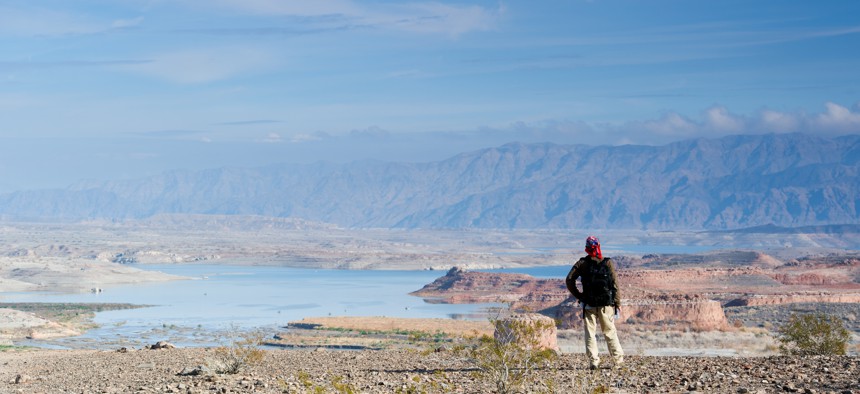Parched Nevada Sees Opportunities in Cloud Seeding

A backpacker looks out over Lake Mead in Nevada. oceanfishing / Shutterstock.com

Connecting state and local government leaders
Drone-assisted drought relief might be option but you “could imagine the reaction that FAA and the public might have to having a unmanned vehicle that is on fire flying through the air.”
Nevada lawmakers are considering legislation to help fund so-called cloud-seeding projects which would be designed to juice more precipitation out of weather systems headed toward the western-facing slopes of the state’s mountains.
The state’s Senate Finance Committee heard testimony on the bill during a meeting last Thursday. If enacted, it would provide $500,000 to the Nevada Department of Conservation and Natural Resources . The money would be used to provide grants for cloud seeding operations.
The bill comes as states across the West have been parched by multiple years of drought, and are headed toward summer with record-low levels of snowpack in the mountains. The extremely dry conditions threaten to leave municipal and agricultural water users in short supply, while also jeopardizing fish habitat and increasing the risk of wildfires.
“Clearly, I think, we all recognize at this point we are in a drought that we’ve never seen before,” Nevada state Sen. Pete Goicoechea said during last Thursday’s Finance Committee meeting.
As of March 31, more than 99 percent of Nevada was experiencing some form of drought conditions, according to figures from U.S. Drought Monitor .

Goicoechea and others who spoke in support of the cloud seeding bill last week see it as a way to increase water supplies in the state.
The effectiveness of cloud seeding has been debated for decades. But estimates presented at the meeting said that it could produce between 82,000 acre feet and 153,220 acre feet of water annually in Nevada depending on the type and scope of the systems that are deployed.
Price estimates also varied, ranging from $3.04 per acre foot, to $12.15 per acre foot.
One acre foot is the amount of water needed to cover one acre of land in 12 inches of water. It is equal to 325,851 gallons. The average American family uses more than 300 gallons of water per day, about 109,500 annually, according the U.S. Environmental Protection Agency.
Under the Nevada bill, the Department of Conservation and Natural Resources would give preference when awarding the grants to local government entities that can provide matching funds. These entities might include municipalities, water authorities, or irrigation districts.
“We don’t expect the state to do this on their own,” Michael Baughman, executive director of the Humboldt River Basin Water Authority said during his testimony to the committee. “I think it’s very important that local parties that have a stake in this put up the money.”
Baughman said that 10 western states use cloud seeding technology.
He also noted that Nevada funded seeding programs from the mid-1980s through 2008, but that the money went away during the recession.
“There are a lot of opportunities for cloud seeding in our state,” he told the committee.
Baughman and others at the meeting described a number of cloud-seeding technologies. These included automated and manually operated ground-based generators that use a propane flame to send plumes containing a seeding agent into the clouds.
The concept behind cloud seeding is that this agent, which is commonly a substance called silver iodide, causes moisture in the cloud to freeze, and produces precipitation.
A similar process can be carried out using an aircraft. But this can be dicey, involving flights in bad weather near mountainous terrain, according to Marc Pitchford, executive director of the Division of Atmospheric Sciences at the Desert Research Institute .
While unmanned aerial vehicles present an alternative that would not put pilots at risk, Pitchford told the committee that getting FAA approval for cloud-seeding drones has been slow.
He pointed out that seeding clouds from a plane involves firing flares off the back of the aircraft’s wings.
“You could imagine the reaction that FAA and the public might have to having a unmanned vehicle that is on fire flying through the air,” he said. “We’re not expecting this to be a easy thing for FAA to give us permission to do, but we are pursuing it.”
Nevada isn’t the only state that has seen recent action related to cloud seeding.
The Wyoming state legislature recently included $1,447,500 in a water projects bill to cover the cost of seeding programs intended to augment snowpack in the Big Horn, Laramie, Medicine Bow and Sierra Madre mountain ranges.
Another $650,000 was set aside for cloud seeding in the Wind River Range. But before any projects start there, the state will seek funding commitments from other water users that rely on that range’s snowpack.
Funding for the Wyoming projects follows the completion of a state-backed study on cloud seeding, which wrapped up last year. Lasting nearly a decade, the study suggested that cloud seeding could increase snowpack by as much as 15 percent during "seedable" storms.
Goicoechea, the Nevada state senator, noted a significant limitation for any cloud seeding program—one that could pose a serious challenge. “With cloud seeding we all understand you’ve got to have clouds to seed,” he said.

NEXT STORY: Rick Scott Walks Back Medicaid-Expansion Support Amid Tense CMS Talks





